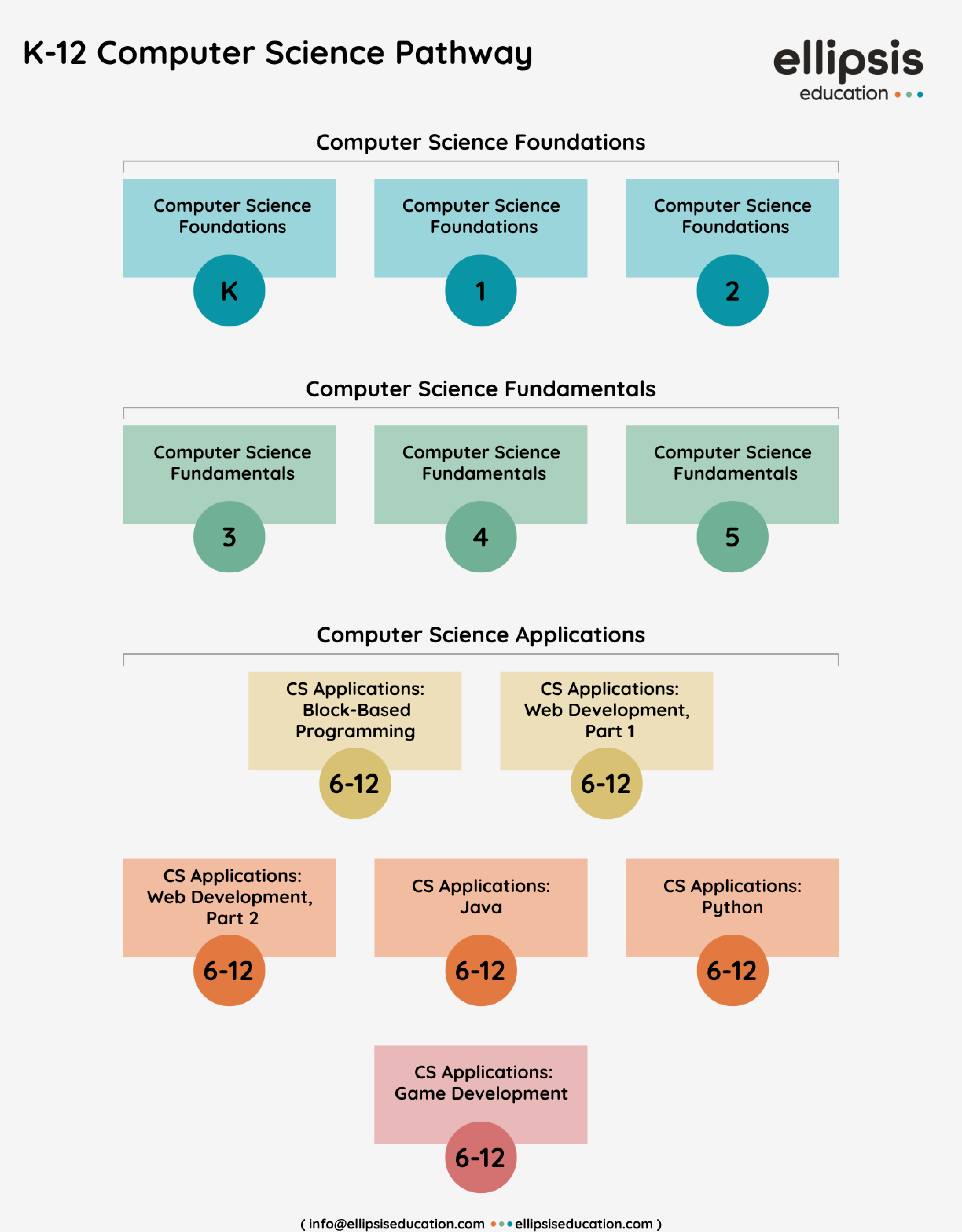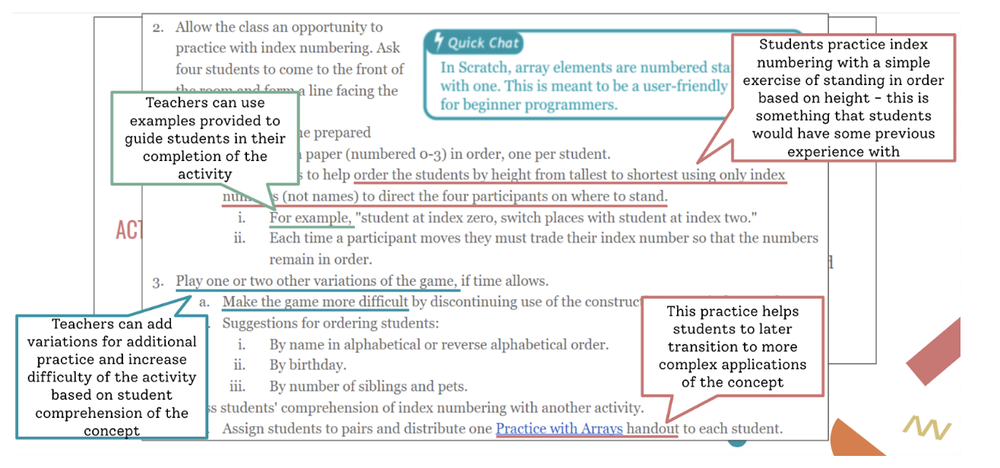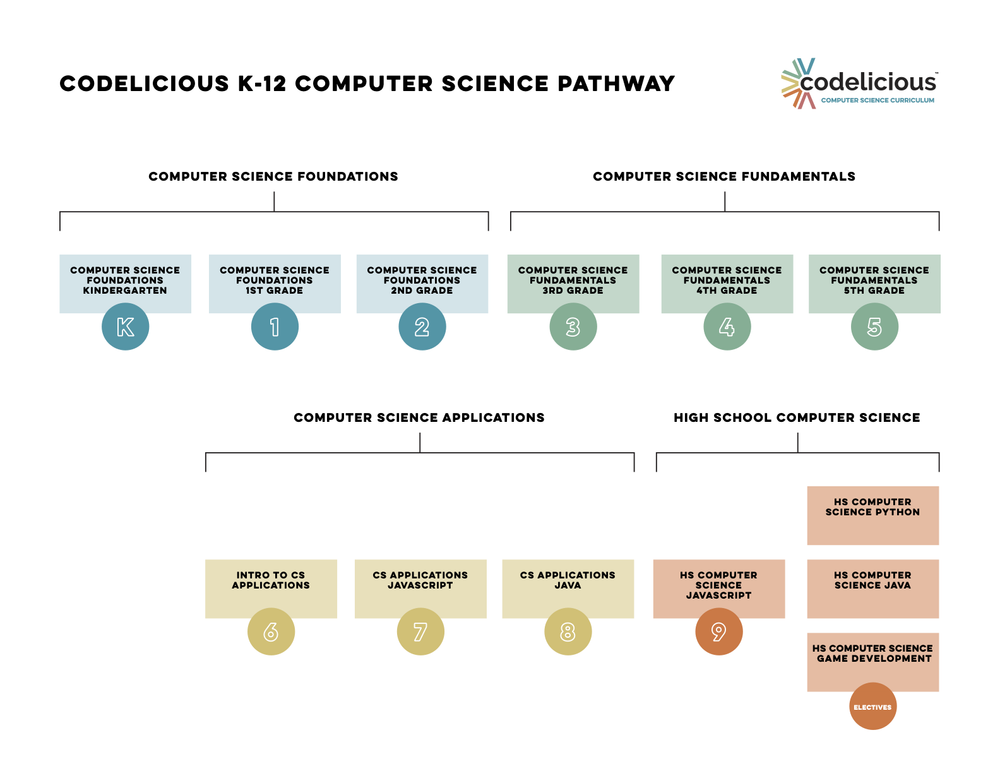Ellipsis Education K-12 Pathway
We understand that high-quality K-12 learning experiences provide continuous opportunities for challenge, growth, and achievement. That is why we developed the Ellipsis Education K-12 Computer Science Pathway. Learn more about the Ellipsis Education Computer Science Pathway below, and download the pathway K-12 curriculum PDF.
Computer Science Pathway Example

As you can see, the Ellipsis Education catalog of courses allows teachers to provide a solution across the K-12 pathway. This journey includes:
-
Grade level differentiation: Curriculum is tailored to students’ abilities and needs.
-
K-12 implementation: Computer science learning happens early and often throughout students’ academic careers.
-
Scaffolds: New learning is always supported by review and connection to prior learning.
All of these factors ensure students are progressing through their computer science journey with age appropriate and rigorous curriculum. To learn more about how the K-12 pathway can honor and build upon your computer science goals, schedule a time to talk with our accounts team.
K12 Pathway Factors and Considerations
Each step of the Ellipsis Education K-12 Pathway empowers teachers with engaging and rigorous curriculum. To achieve this, Ellipsis Education curriculum writers consider several key factors as they develop each course. Learn more about each factor below or in our K-12 journey video.
- Educational content: Lessons are standards aligned and continually updated to reflect changes in the computer science field.
- Curriculum progression: New learning (whether that is within a course or across a grade band) is always supported by review and connection to prior learning.
- Pedagogical methods: Best practices embedded within lessons give teachers insights into how to craft learning experiences that best meet the needs of their students.
- Equitable learning environments: Technology used in Ellipsis Education courses mimic the tools used by professional computer scientists while giving teachers options based on internet access and resource availability.
- Developmental appropriateness: Students learn concepts that are suitable for their physical, cognitive, and social milestones.
Ellipsis Education curriculum uses this framework to create the best possible computer science learning experience for students.
What is Scaffolding in Education?
Scaffolding in education can be defined as the process through which teachers provide support to students as they expand their existing knowledge base and gradually remove supports as students become more comfortable with the material. The characteristics of scaffolding can be compared to teaching a child to ride a bicycle; they may start with training wheels, then an adult may hold on to the back of the seat, and finally, the child is riding the bike on their own. There are three broad categories of scaffolding strategies:
-
Modeling: Lessons include think alouds (teachers show students the way to think through a problem), demonstrations (teachers show students the correct approach), or checks for understanding (teachers ask questions to gauge students’ understanding of the material and increase or decrease support as needed).
-
Building on Prior Knowledge: Teachers levy students’ existing experiences as a foundation for the new material. Students apply skills and make connections between what they already know and what they are learning.
-
Breaking Down Material: Teachers introduce concepts to students in chunks progressing from easy to hard. Teachers can use questioning to help guide students through different stages of the learning experience.
Ellipsis Education curriculum uses these scaffolding teaching strategy examples and more to ensure that new learning is supported by connection to prior learning. Scaffolding happens within a single lesson, at the beginning, middle, and end of a course, as well as across courses or even grade bands. Thus, scaffolding is the concept that makes the K-12 Pathway an effective tool for teachers and students alike. Keep reading to learn more about the benefits of scaffolding and explore an example.
Importance of Scaffolding in Education
What are some of the benefits of scaffolding in education? First, scaffolding strategies build student proficiency with new skills. As students become more familiar with a concept, teachers remove supports so learning can grow deeper and more complex over time. Second, scaffolding instills confidence in students. Repeated learning experiences create a strong foundation so students can make connections to other concepts or prior knowledge. Finally, scaffolding helps students build learning momentum. Teachers can make adjustments to ensure students are presented with the right support that they need to master new things.
As computer science becomes more of a focus in classrooms across the nation, real life examples of scaffolding may aid teachers in their implementation of high-quality curriculum. Let’s explore scaffolding examples from Ellipsis Education curriculum. Our scaffolding in education examples come from our Computer Science Fundamentals grade band. In an unplugged activity, students learn the basics of arrays by simulating a demonstration of dynamic lists with their classmates. There are multiple scaffolds included in this lesson:
-
To represent index numbers, students are instructed to order themselves by height. Students have likely had experience with this conversation – who’s shorter? Who’s taller?
-
Teachers provide an example of the types of programming language students should be using to achieve the task. This helps learners build upon their existing knowledge of height and encourages them to use computer science vocabulary .
-
Finally, teachers are given suggestions on how to make variations to the activity to either review the concepts or increase difficulty.

These scaffolds all take place in a single lesson; however, scaffolding and review is incorporated in all points of the Ellipsis Education K-12 Pathway. See another example of scaffolding by downloading our free Digital Security Analyst lesson for grades 6-8.
K12 Career Prep
Incorporating K12 technology into instruction is imperative as the demand for digitally literate professionals increases. Currently, there are more than a half-million computer science and information technology positions in the United States that remain unfilled. Given this, it is important that we help raise awareness around future employment opportunities for students.
Exploring K12 careers in the classroom encourages students to consider the wide variety of professions that are influenced by computer science. That is why Ellipsis Education incorporates STEM Career lessons across the K-12 Pathway. Most lessons begin with a video and discussion, allowing the educator to raise awareness about a specific STEM career. Students consider the specific training and traits required of a person in this field. Then, students assume the role of the professional, completing a hands-on activity that mirrors the daily work of that particular STEM career. For example, in the Aviation lesson for grade 6, students organize data similar to the way a pilot has to coordinate information before a flight. To explore another example, download a free STEM Career lesson for grades 9-12 on our website.
K12 career prep goes outside of these specific STEM Career lessons, though. Digital Citizenship lessons give students the opportunity to discuss the importance of respectful, safe, and ethical technology use. These lessons provide students with the skills they need to grow and thrive in the digital world, which will benefit them in any career they choose to pursue. To see an example from Ellipsis Education curriculum, download a free Digital Citizenship lesson for grades 6-8.
Another way to facilitate K12 Career Prep is through K12 CTE (Career and Technical Education) programs. While the standards span from kindergarten through 12th grade, most programs today begin in high school. CTE programs are typically organized into career clusters that include a wide variety of professions, from agriculture to health science to computer science. The CTE program standards include occupation, industry, and career specific knowledge, alongside opportunities for further career exploration. Explore specific standards and CTE pathway examples on the Advance CTE website. Additionally, sample crosswalks to the STEM Career Cluster – Knowledge and Skill Statements have been created for each Ellipsis Education course. Schedule a Ellipsis Education demo with our accounts team to learn more about specific career clusters and courses.
How to Become a K-12 Teacher
The Ellipsis Education K-12 Pathway is just one method of effective instruction. At Ellipsis Education, though, we know that teachers are the single most important predictor of student success. You may wonder about how to become a teacher that can inspire learners every day.
In general, you might ask, “Where will I get the education to become a teacher?”. How to become a teacher in USA can vary greatly depending on your post secondary education, state certification requirements, and desired position within a given district. For example, if you’re wondering how to become a high school teacher, you likely need to earn your Bachelor’s degree, hold a state-specific teaching license, and pass a core content exam. On the other hand, if you want to hold a school or district administrative position (like principal or superintendent), you probably need to earn a master’s degree. A K-12 teacher salary is usually dependent on your level of education as well as your years of experience. You can find out more specific information and requirements by looking at your state’s Department of Education website.
What college courses are needed to become a teacher? Coursework will vary greatly depending on your school, but most programs offer courses in cognitive development, psychology, and curriculum design. You may also take courses in the specific subject areas you wish to teach. Most undergraduate programs also require a year of student teaching, where aspiring teachers can take what they’ve learned and apply it in a real classroom setting.
Regardless of your teaching background, Ellipsis Education is confident that any educator can become a computer science teacher. Success in computer science is much more than just coding; it’s being a problem-solver, thinking critically, and having the ability to collaborate effectively with peers. Seeking growth in these essential skills is just as applicable for teachers as it is for students. If you’re looking for additional words of wisdom, we spoke with teacher, blogger, and podcaster Vicki Davis (Cool Cat Teacher) in our My STEM Career podcast. In this interview, listen to her advice for starting to learn and teach computer science in your classroom.
K-12 Curriculum
Ellipsis Education provides full-year K-12 computer science curriculum that aligns with your school or district’s adopted computer science standards. The curriculum offers grade level differentiated learning pathways, aligns with all state and national computer science standards, and is continually updated to reflect changes in computer science. Ellipsis Education courses are customized to districts’ unique instructional strategy for computer science integration. This can mean incorporating computer science into an existing class period, adding to a specials rotation, or introducing a stand alone class. Courses are delivered with instructional resources teachers need to feel confident teaching computer science in K-12.
Our computer science curriculum for K-2 empowers you to engage your students with courses that fuel their interest. Coding lessons use ScratchJr, an introductory block coding language, perfect for emergent and early readers.
In grades 3-5, inspire your students with courses that spark their creativity. Coding lessons use Scratch, a block based coding language, ideal for the transitional and fluent reader.
Our computer science curriculum middle school (6-8) helps you motivate your students with courses that connect to their world. Coding lessons use line based languages JavaScript, HTML, CSS, and Java to explore programming options.
Our computer science high school curriculum (9-12) helps you empower your students with courses that expand their skills. Coding lessons use JavaScript, Java, Python, and Godot to develop websites, programs, and games.
K-12 Pathway Example

As you can see, the Ellipsis Education catalog of courses allows teachers to provide a solution across the K-12 pathway. This journey includes:
-
Grade Level Differentiation: Curriculum Is Tailored To Students’ Abilities And Needs.
-
K-12 Implementation: Computer Science Learning Happens Early And Often Throughout Students’ Academic Careers.
-
Scaffolds: New Learning Is Always Supported By Review And Connection To Prior Learning.
All of these factors ensure students are progressing through their computer science journey with age appropriate and rigorous curriculum. To learn more about how the K-12 pathway can honor and build upon your computer science goals, schedule a time to talk with our accounts team. To view a PDF version of our computer science pathway, click below.
